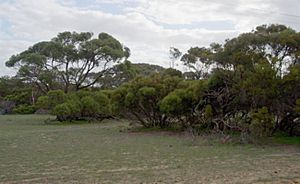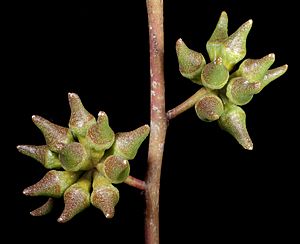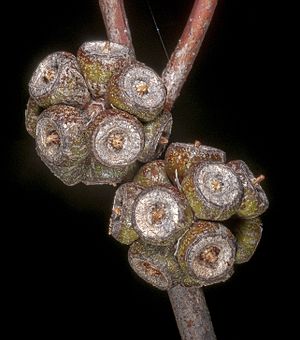Redheart facts for kids
Quick facts for kids Redheart |
|
|---|---|
 |
|
| Eucalyptus decipiens growing near Seabird, Western Australia | |
| Scientific classification | |
| Genus: |
Eucalyptus
|
| Species: |
decipiens
|
| Synonyms | |
|
|
Eucalyptus decipiens, commonly known as redheart or redheart moit, is a special type of mallee or small tree. It is found only in Western Australia, meaning it is endemic to that area. This plant has bark that can be rough and brownish, often peeling off in ribbons. It also has smooth bark that is whitish or grey. Its adult leaves are shaped like a spear, and its flower buds grow in groups. The fruit of the redheart tree looks like a cone or a flattened half-sphere.
What Redheart Looks Like
The Eucalyptus decipiens is usually a mallee, which is a type of tree that has many stems growing from a large underground woody base called a lignotuber. It can also be a small tree. It typically grows to be about 1.5–15 m (4 ft 11 in – 49 ft 3 in) (5 to 49 feet) tall and 3–6 m (9.8–19.7 ft) (10 to 20 feet) wide.
Its bark is often rough and flaky, with greyish-brown ribbons. Some parts of the bark are smooth and can be grey or pinkish. Young plants and new shoots (called coppice regrowth) have leaves that are broadly oval or almost round. These leaves are a dull bluish-green and measure 20–65 mm (0.79–2.56 in) (0.8 to 2.6 inches) long and 20–50 mm (0.79–1.97 in) (0.8 to 2.0 inches) wide.
Adult leaves grow one after another along the stem. They are thick, dull, and grey-green, shaped like a spear with a hooked tip. These leaves are 55–125 mm (2.2–4.9 in) (2.2 to 4.9 inches) long and 10–25 mm (0.39–0.98 in) (0.4 to 1.0 inches) wide. They grow on a flattened stalk called a petiole, which is 4–22 mm (0.16–0.87 in) (0.2 to 0.9 inches) long.
The flower buds of the redheart tree grow in groups of eleven to twenty-one. These groups are on a main stalk called a peduncle, which is 3–12 mm (0.12–0.47 in) (0.1 to 0.5 inches) long. Each individual bud either sits directly on the stalk (is sessile) or has a very short stem (a pedicel) up to 3 mm (0.12 in) (0.1 inches) long.
When the buds are ready to open, they are oval or spindle-shaped. They are 7–12 mm (0.28–0.47 in) (0.3 to 0.5 inches) long and 3.5–5 mm (0.14–0.20 in) (0.1 to 0.2 inches) wide. Each bud has a cap-like structure called an operculum that is conical or beaked. Redheart flowers are creamy white and bloom between August and January.
After flowering, the plant produces a woody fruit. This fruit is a capsule that is shaped like a cone or a flattened half-sphere. It measures 4–6 mm (0.16–0.24 in) (0.2 to 0.2 inches) long and 5–9 mm (0.20–0.35 in) (0.2 to 0.4 inches) wide.
How Redheart Got Its Name
The scientific name Eucalyptus decipiens was first officially described in 1837. This was done by a botanist named Stephan Endlicher. He studied a plant sample that was collected near King Georges Sound by Charles von Hügel.
The description was published in a book called Enumeratio plantarum quas in Novae Hollandiae ora austro-occidentali ad fluvium Cygnorum et in sinu Regis Georgii collegit Carolus Liber Baro de Hügel. The second part of the name, decipiens, comes from the Latin word decipio. This word means "to trick" or "to cheat." It's not completely clear why Endlicher chose this name, but it might be because the plant looks very similar to another species.
Some different types of Eucalyptus decipiens have been described, like E. decipiens subsp. chalara. However, these names are not officially recognized by the Australian Plant Census.
Where Redheart Grows
Redheart is found in several regions of Western Australia. These include the Wheatbelt, South West, and Great Southern areas.
It grows in various places like sandplains, on hills, and along the edges of swamps. The plant prefers to grow in clay, loam, or sandy soils that are found over a type of rock called laterite.



